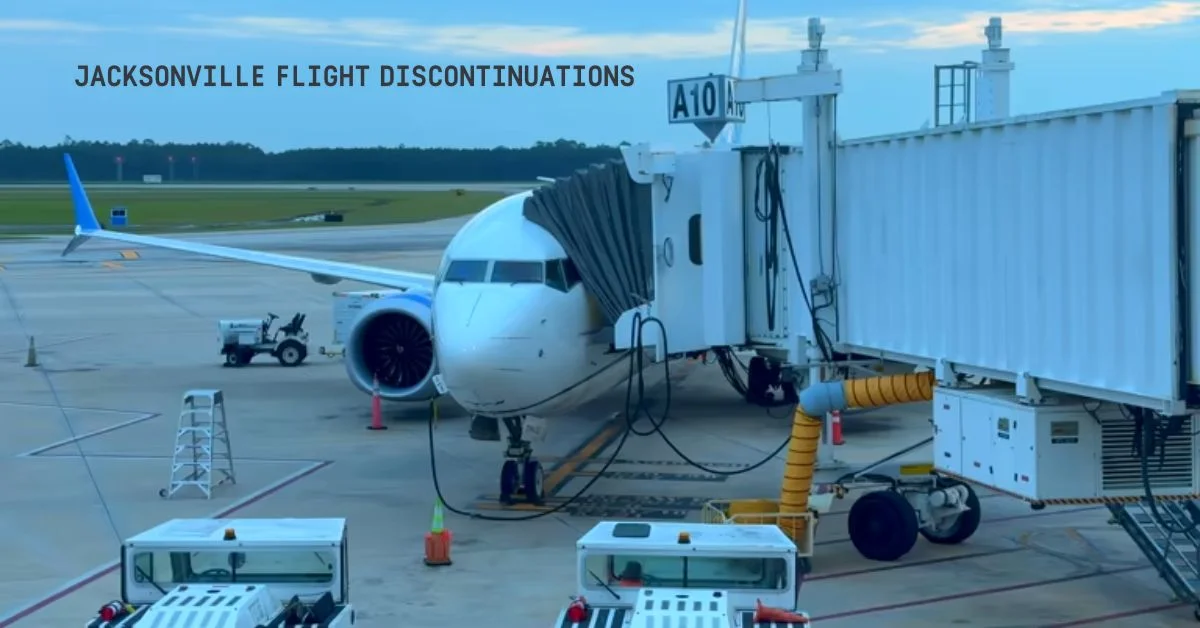General
Jacksonville Flight Discontinuations: What Travelers Should Know

Introduction to the issue of flight discontinuations in Jacksonville
Jacksonville, known for its stunning beaches and vibrant culture, has recently faced a troubling trend: flight discontinuations. For travelers relying on this bustling airport to connect them to various destinations, the news can be more than just an inconvenience. As routes vanish and options dwindle, understanding what’s happening becomes crucial for anyone planning a trip from Jacksonville.
The impact of these changes extends beyond individual inconveniences; it ripples through the local economy as well. Whether you’re a frequent flyer or someone who enjoys an occasional getaway, knowing how to navigate these challenges is essential. Let’s dive into the reasons behind these flight disruptions and explore what they mean for you as a traveler in Jacksonville.
Reasons for flight discontinuations
Flight discontinuations can occur for various reasons, each impacting travelers differently. One primary factor is the fluctuating demand for air travel. Airlines continuously evaluate passenger numbers, and if a route consistently underperforms, it may be cut.
Operational challenges also play a significant role. Aircraft availability issues or staffing shortages can lead to reduced schedules or outright cancellations of certain flights.
Regulatory changes often influence flight routes too. New safety regulations or shifts in aviation policies might prompt airlines to reconsider their operations.
Economic factors cannot be overlooked either. Rising fuel costs and inflation pressures can make specific routes less profitable, leading to tough choices for airlines.
Competition shapes these decisions as well. If rival carriers dominate certain markets with more attractive service offerings or pricing strategies, an airline may opt to withdraw from that space entirely.
Impact on travelers and the local economy
Flight discontinuations in Jacksonville ripple through the travel experience. Passengers face uncertainty and frustration when their planned journeys are disrupted. This can lead to missed connections, unexpected delays, and an overall feeling of chaos.
The local economy also takes a hit. Airlines contribute significantly to job creation and tourism revenue in the area. Reduced flight options can deter visitors who choose alternative destinations with better connectivity.
Businesses that rely on traveling customers may struggle as well. Hotels, restaurants, and attractions depend on steady tourist traffic for survival. When flights dwindle, so does foot traffic – leading to potential layoffs or closures.
Residents also feel the effects when family members find it challenging to visit or return home due to fewer available routes. The sense of community ties is strained as travel becomes more complicated than before.
Steps taken by airlines and airports to mitigate the issue
Airlines and airports are actively working to address the challenges posed by Jacksonville flight discontinuations. They are enhancing their communication strategies, ensuring travelers are informed about potential changes in real time.
Many airlines have introduced flexible booking policies. These allow passengers to rebook flights without hefty fees if disruptions occur. This measure eases stress for those affected by sudden cancellations.
Airports are also improving infrastructure and services. Upgrades to facilities can enhance operational efficiency and reduce delays. Additionally, they’re collaborating closely with local businesses to boost passenger experience during layovers or wait times.
Training programs for staff on customer service skills have been implemented as well. Employees equipped with better tools can provide immediate assistance, helping alleviate traveler frustrations when issues arise.
Alternative travel options for affected travelers
For travelers impacted by Jacksonville flight discontinuations, exploring alternative options can ease the stress. Consider road trips as a practical choice. Renting a car allows flexibility and the chance to discover scenic routes along the way.
Train travel is another viable option. Amtrak services connect Jacksonville with several major cities, offering comfort and beautiful landscapes.
If time permits, consider bus services like Greyhound or Megabus. They provide affordable fares for long-distance journeys while ensuring safe transit.
Additionally, regional airports nearby may offer flights that suit your needs. A short drive could lead you to new destinations without hassle.
Don’t overlook rideshare programs or even carpooling with fellow travelers heading in the same direction. Splitting expenses could transform a hassle into a fun and memorable journey!
What passengers can do to protect themselves from flight disruptions
Travelers can take several proactive measures to shield themselves from flight disruptions. Staying informed is crucial. Sign up for airline alerts or download apps that provide real-time updates on your flight status.
Consider booking direct flights when possible. They often reduce the chances of cancellations and delays associated with layovers.
Pack essentials in your carry-on bag. This covers essentials like medications, phone chargers, snacks, and a fresh set of clothes. Being prepared means you won’t be caught off guard in case of unexpected delays.
Flexibility is key during travel. If your itinerary allows for it, look into alternate routes or even different airlines as options if an issue arises.
Familiarize yourself with the airline’s policies regarding cancellations and rebooking procedures ahead of time to navigate any changes smoothly should they occur.
Conclusion and advice for future travels
Navigating through the recent flight discontinuations in Jacksonville can be challenging, but there are ways to stay ahead. Staying informed about the latest routes and schedules is crucial.
Travelers should always check for updates directly from airlines and airports before planning their trips. Signing up for fare alerts can also help you find alternative flights quickly.
Consider flexibility when booking travel plans. If your preferred route is unavailable, being open to connecting flights or nearby airports could save time and money.
Investing in travel insurance may provide peace of mind during uncertain times like these. It’s a small step that can protect against unexpected disruptions.
With a proactive approach and by exploring all available options, travelers can navigate the shifting landscape of air travel more effectively while minimizing inconvenience along the way.
General
FREHF Uncovered: How It Shapes Innovation and Lifestyle Today

In a rapidly changing world, new concepts emerge that redefine the way we think about innovation and lifestyle. One such concept gaining traction is FREHF. This intriguing term encompasses a blend of ideas shaping our everyday experiences and driving technological advancements. As we navigate through this ever-evolving landscape, understanding FREHF becomes essential for anyone looking to stay ahead of the curve.
Imagine a framework where creativity meets practicality, influencing everything from how we work to how we live. It’s not just about gadgets or trends; it’s a holistic approach that integrates various facets of modern life. Curiosity piqued? Let’s delve deeper into what FREHF truly means and discover its profound impact on innovation and lifestyle today.
The Meaning of FREHF
FREHF stands for Future-Ready, Efficient, Holistic Framework. At its core, it represents a mindset that prepares individuals and organizations for the challenges of tomorrow.
The ‘Future-Ready’ aspect emphasizes adaptability. It’s about anticipating trends and technologies before they become mainstream. The world is in constant flux, and being prepared gives you an edge.
Next comes ‘Efficient.’ This focuses on maximizing resources while minimizing waste. Efficiency isn’t just about saving time; it’s also about smart decision-making in everyday life.
The term ‘Holistic’ highlights the interconnectedness of various elements—technology, environment, and society. FREHF encourages viewing problems from multiple perspectives to find comprehensive solutions.
Finally, ‘Framework’ implies structure—a systematic approach to navigating complexities with clarity and purpose. Together, these components create a powerful tool for innovation that resonates across industries and personal growth alike.
Impact of FREHF on Innovation
The impact of FREHF on innovation is profound. This approach fosters innovation and teamwork across multiple industries.
With FREHF, boundaries blur between traditional industries. Startups and established companies alike are finding new ways to innovate together. The emphasis on holistic approaches fosters an environment ripe for groundbreaking ideas.
FREHF promotes experimentation. It allows teams to test concepts without the fear of failure. Instead, each setback becomes a learning opportunity that drives progress forward.
Moreover, it attracts diverse talent by valuing unique perspectives. When people from different backgrounds collaborate, they bring fresh insights that can lead to revolutionary developments.
Companies adopting the FREHF mindset often experience accelerated growth rates as they harness collective creativity and adaptability in problem-solving processes.
In this way, FREHF shapes not only products but also entire business models that redefine market standards and consumer experiences.
The Connection Between FREHF and Lifestyle
FREHF isn’t just a concept; it’s a way of life. It influences how we approach daily routines, wellness, and even our social interactions.
At its core, FREHF encourages mindfulness. People begin to prioritize mental well-being alongside physical health. This shift leads to healthier choices in diet and exercise.
Moreover, FREHF fosters community engagement. Individuals seek out like-minded people who share similar values and interests. Community support enhances personal growth and innovation.
The essence of FREHF also emphasizes sustainability. Many embrace eco-friendly practices that resonate with their lifestyle choices.
The integration of FREHF into everyday living creates an enriching atmosphere filled with purpose and positivity. It’s about making conscious decisions that align with one’s values while fostering connections within the community.
Examples of FREHF in Action
FREHF manifests in various sectors, showcasing its versatility and impact. In the tech industry, companies like Tesla leverage FREHF principles to create sustainable energy solutions. Their innovations not only reduce carbon footprints but also redefine consumer expectations.
In healthcare, telemedicine platforms embody FREHF by making quality care accessible remotely. Patients can consult doctors from the comfort of their homes, transforming traditional healthcare models.
Fashion brands are also adopting FREHF, spearheading the movement with sustainable materials.Brands like Patagonia prioritize sustainability while appealing to conscious consumers looking for stylish yet responsible choices.
Even in community initiatives, local gardens promote urban biodiversity through collaborative efforts. These projects illustrate how FREHF fosters connection and innovation at grassroots levels.
Everywhere you look, FREHF is reshaping approaches and inspiring new ways of thinking across industries. The real-world applications keep expanding as more people recognize its potential benefits.
Challenges of Embracing FREHF
Embracing FREHF is not without its hurdles. One significant challenge is the resistance to change. Many individuals and organizations are accustomed to traditional methods, making it difficult to adopt new paradigms.
Another obstacle lies in understanding the principles of FREHF itself. The complexity can be overwhelming for newcomers. This steep learning curve often deters people from fully engaging with innovative frameworks.
Additionally, there’s a lack of resources dedicated to implementing FREHF strategies effectively. Accessing training or support can be limited, leading to frustration among those eager to adapt.
Cultural differences also play a role in the acceptance of FREHF concepts. What works well in one community may not resonate elsewhere, complicating collaborative efforts across diverse backgrounds.
Fear of failure looms large as individuals take risks associated with adopting new practices rooted in FREHF philosophy. These fears can stifle creativity and limit exploration within innovation-driven environments.
How to Incorporate FREHF into Your Life
Incorporating FREHF into your life begins with a mindset shift. Embrace curiosity and openness to new ideas. This helps you see opportunities where others may not.
Start by integrating FREHF’s principles into daily routines. Evaluate your habits—are they innovative or stagnant? Make small adjustments that encourage creativity, like trying a new hobby or taking a different route to work.
Connect with communities that embody FREHF values. Engage in discussions, share experiences, and learn from others who are passionate about innovation. Networking can spark inspiration.
Set goals focused on growth rather than perfection. Celebrate progress over completion; each step is part of the journey toward embracing this transformative approach.
Reflect regularly on your experiences. Journaling can help identify areas for improvement while reinforcing what resonates most with you in the context of FREHF’s principles.
Conclusion
FREHF, which stands for Future Ready and High-Performance Framework, isn’t just a buzzword—it’s a transformative approach that shapes how we innovate and live. Its influence can be felt across various sectors as it drives new ideas and methodologies.
By embracing FREHF principles, individuals and organizations can foster an environment ripe for creativity. This framework promotes collaboration, adaptability, and efficiency. These qualities are essential in today’s fast-paced world.
The connection to lifestyle is equally significant. FREHF’s encourages mindfulness about our choices, pushing us toward sustainable practices while enhancing overall well-being. It inspires people to lead lives that align with their values.
Real-world examples of FREHF’s illustrate its far-reaching impact—from tech startups using agile methodologies to improve products rapidly to educational institutions integrating these principles into curricula designed for future success.
Yet challenges exist when adopting this innovative framework. Resistance to change is common; some may find it difficult to shift old habits or traditional mindsets.
Integrating FREHF’s into daily life doesn’t have to be daunting. Start small by fostering open communication with others around you or making conscious decisions that prioritize sustainability.
As the landscape continues evolving, those who understand and implement the tenets of FREHF will likely thrive in both innovation and personal development.
General
delta flight dl275 japan diversion lax: Full Timeline & Causes

Introduction to the Delta Flight DL275 Japan Diversion
A typical flight from Tokyo to Los Angeles took an unexpected turn when Delta Flight DL275 found itself diverted mid-air. What should have been a straightforward journey quickly transformed into a series of unexpected events that impacted passengers and crew alike. As the plane made its way across the Pacific, no one could foresee the twists that were about to unfold. In this post, we’ll explore the full timeline of delta flight dl275 japan diversion lax, examine possible causes, and delve into how both passengers and airlines managed the situation. Buckle up as we navigate through this intriguing air travel story!
The Timeline of Events
The timeline of Delta Flight DL275’s diversion on its route to Japan unfolds with a series of unexpected events.
Initially, the flight took off from Los Angeles International Airport as scheduled. Passengers settled in for what they anticipated would be a smooth journey across the Pacific.
Approximately two hours into the flight, crew members reported an unusual situation developing on board. This prompted immediate communication with air traffic control.
As concerns escalated, pilots made the decision to change course and head toward LAX. The plane turned around, retracing its path over California skies while passengers braced themselves for uncertainty.
Within minutes, ground crews prepared for an emergency landing back at Los Angeles. The original flight plan was discarded as safety became paramount.
With careful coordination between cockpit and ground staff, DL275 landed safely back at LAX shortly thereafter.
Possible Causes of the Diversion
Several factors may have contributed to the diversion of Delta Flight DL275. Weather conditions are often a primary concern for pilots. Severe turbulence or unexpected storms can prompt quick decisions.
Mechanical issues also play a significant role in such diversions. Anomalies with aircraft systems might lead the crew to prioritize passenger safety above all else.
Medical emergencies on board present another possibility. If a passenger requires immediate attention, diverting to the nearest airport becomes crucial for their well-being.
Communication failures between air traffic control and the flight crew could potentially complicate matters further. Any lapse in information flow necessitates cautious responses from pilots navigating through busy airspace.
Security threats cannot be overlooked entirely. While rare, any indication of danger would trigger protocols aimed at ensuring everyone’s safety during transit.
Passenger and Crew Reactions
The reactions from passengers aboard Delta Flight DL275 were a mix of surprise and anxiety. Many travelers had been looking forward to their journey, so the sudden diversion was a shock.
As news spread through the cabin, some expressed concern about what might be happening. Others turned to their phones for updates or reached out to loved ones on the ground.
Crew members worked tirelessly to maintain calm amid uncertainty. They reassured passengers with clear communication and provided necessary information as soon as it became available. Their professionalism helped ease fears during this unexpected turn of events.
Despite the situation, some passengers found moments of camaraderie, bonding over shared experiences in an unusual circumstance. Laughter broke out among small groups as they exchanged stories and offered support to one another amidst rising tension in the air.
Impact on Passengers and Airlines
The diversion of Delta Flight DL275 had immediate consequences for passengers on board. Frustration mounted as travelers faced uncertainty about their arrival times and connecting flights. Some found themselves stranded, scrambling to rebook travel plans.
Airlines also felt the ripple effects. The unexpected landing in Los Angeles disrupted schedules and created a domino effect throughout the day’s operations. Other flights experienced delays as staff worked to accommodate affected passengers.
For Delta, customer satisfaction took center stage amid the crisis. They quickly mobilized teams at LAX to assist with logistics, offering meals and accommodations where needed.
This incident highlighted how interconnected air travel is; one flight can impact many others across multiple routes. Airlines continuously assess these situations to improve response strategies, ensuring they remain prepared for future disruptions while keeping passenger comfort in mind.
Safety Measures and Protocols in Place for Diverted Flights
Airlines implement a variety of safety measures and protocols to ensure the well-being of passengers during diverted flights. These measures are critical in managing unexpected situations.
Crew training is essential. Flight attendants and pilots undergo rigorous simulations that prepare them for emergencies, including diversions. They learn how to communicate effectively with passengers while maintaining calmness.
Onboard resources also play a vital role. Flights are equipped with emergency kits that include first aid supplies, communication devices, and other necessary equipment designed for unforeseen circumstances.
Air traffic control coordination is another key aspect. Ground teams work closely with flight crews to provide real-time updates on weather conditions and airport statuses, helping determine the safest landing options available.
Passenger safety remains paramount throughout these processes. The focus is always on minimizing disruptions while ensuring everyone reaches their destination safely and efficiently.
Conclusion
The Delta Flight DL275 Japan diversion LAX has become a significant event that highlights the complexities of air travel. The timeline illustrates how quickly circumstances can change, putting both passengers and crew in unexpected situations. Understanding possible causes sheds light on operational challenges airlines face today.
Passenger reactions varied from frustration to confusion, reflecting the stress that diversions can bring. Airlines need to navigate these scenarios carefully, ensuring safety while managing customer expectations effectively.
This incident serves as a reminder of the stringent safety measures in place for diverted flights. These protocols are designed not only for emergencies but also for routine changes during travel.
As travelers continue to rely on air transportation, events like this remind us of the unpredictable nature of flying and the importance of efficient crisis management by airlines.
General
Hitaar: Exploring the Sacred Tradition Shaping Japanese Heritage

Introduction to Hitaar
Japan is a land steeped in tradition and rich cultural heritage. Among its many sacred practices, Hitaar stands out as a profound expression of spirituality and community bonding. This ancient tradition, rooted deeply in the Japanese way of life, reflects values that are still relevant today. As we embark on this exploration of Hitaar, you’ll discover how it shapes not only individual lives but also the very fabric of Japanese society. From its historical origins to modern adaptations, Hitaar offers insight into what it means to be part of a culture that reveres both nature and ancestry. Join us as we uncover the layers of meaning behind this cherished practice and understand why it remains vital for future generations.
The Origins and History of Hitaar
Hitaar has roots that trace back centuries. It emerged in the rich tapestry of Japanese spirituality and culture, intertwining with local folklore and religious practices.
Historically, Hitaar was more than just a ritual; it served as a bridge between the earthly realm and spiritual dimensions. Communities gathered to honor their ancestors, invoking blessings through its sacred ceremonies.
Over time, various regions adapted their unique interpretations of Hitaar, leading to diverse expressions across Japan. This evolution reflects the country’s dynamic cultural landscape while maintaining core principles rooted in respect for nature and reverence for deities.
Artifacts from ancient times reveal how integral Hitaar was to communal life. These practices fostered unity among villagers, reinforcing social bonds that still resonate today within modern communities celebrating this tradition. Each layer added throughout history contributes to its depth and significance within Japanese heritage.
The Role and Significance of Hitaar in Japanese Culture
Hitaar holds a unique place in the tapestry of Japanese culture. It transcends mere tradition; it embodies spirituality and connection to the past.
This sacred practice fosters community, as families gather to partake in rituals that strengthen their bonds. Each ceremony serves not only as a remembrance but also as a celebration of life’s cycles.
In Japan, Hitaar is more than cultural preservation. It encourages respect for nature and ancestral wisdom, emphasizing harmony with one’s environment. This philosophy resonates deeply within everyday life.
Artistic expressions related to Hitaar flourish too. From intricate textiles to delicate pottery, artisans draw inspiration from this rich heritage. These creations further anchor today’s society in its roots.
As generations embrace Hitaar, they weave its teachings into modern narratives while honoring age-old practices that continue to shape identities across Japan.
Traditional Practices and Rituals Associated with Hitaar
Traditional practices surrounding hitaar are deeply rooted in reverence and spirituality. Communities often gather to participate in various ceremonies that honor the ancestral spirits. These meetings create a feeling of connection and uphold continuity.
One common ritual involves the creation of intricate offerings, such as food and handmade crafts, symbolizing gratitude for blessings received. Participants might chant prayers while lighting incense, creating an atmosphere filled with sacred energy.
Another significant practice is storytelling. Elders share tales of past generations, preserving wisdom through oral traditions. This not only connects individuals to their heritage but also strengthens community bonds.
Seasonal festivals dedicated to hitaar attract participants from distant regions. Vibrant displays of cultural art and dance bring life to ancient narratives, ensuring they endure in collective memory. Each event encapsulates the essence of Japanese identity while nurturing respect for nature’s beauty and balance within society.
Modern Adaptations and Evolution of Hitaar
Modern adaptations of Hitaar reflect a dynamic blend of tradition and contemporary influences. While the core principles remain intact, new interpretations have emerged in various forms.
Artisans now incorporate modern materials into traditional practices. This fusion not only appeals to younger generations but also broadens the audience for this sacred tradition. Workshops and classes are popping up across Japan, encouraging participation from those unfamiliar with Hitaar’s deep roots.
Digital platforms play a vital role in spreading awareness. Social media showcases vibrant images and videos of rituals, attracting interest globally. Virtual tours offer insights into ceremonies that were once reserved for localized communities.
Additionally, collaborations with fashion designers highlight Hitaar motifs in clothing and accessories. These initiatives bridge cultural gaps while maintaining respect for its origins, ensuring that the essence of Hitaar continues to thrive amidst changing times.
Impact of Hitaar on Japanese Heritage and Tourism
Hitaar plays a vital role in shaping Japan’s cultural landscape. This sacred tradition attracts both locals and tourists alike, creating a vibrant tapestry of shared experiences.
Visitors are drawn to the serene beauty of Hitaar rituals. They find themselves immersed in the spirituality that permeates ceremonies and gatherings. The authenticity of these practices fosters a deeper understanding of Japanese heritage.
Tourism thrives around Hitaar sites, enhancing local economies. Small towns see an influx of visitors eager to witness traditional performances or partake in seasonal festivals. These events not only celebrate Hitaar’s but also offer unique interactions between cultures.
Moreover, educational programs centered on Hitaar promote awareness among younger generations. Schools increasingly incorporate lessons about this rich tradition into their curricula, ensuring its relevance for years to come.
As more people recognize its significance, advocacy for preserving Hitaar’s continues to grow within communities across Japan.
Conclusion: Preserving the Sacred Tradition of Hitaar for Future Generations
Hitaar serves as a vital link between the past and present of Japanese culture. This sacred tradition, steeped in history and meaning, has shaped the identity of communities for centuries. Its practices reflect a deep reverence for nature and spirituality, creating an enduring sense of belonging.
As modern society continues to evolve, maintaining the essence of Hitaar becomes more crucial than ever. Efforts to preserve this heritage not only enrich local communities but also attract interest from global travelers eager to learn about Japan’s unique traditions.
Education plays a key role in ensuring that future generations appreciate the significance of Hitaar’s. Workshops, cultural festivals, and community gatherings can help pass down knowledge while fostering respect for these age-old customs.
The beauty of Hitaar lies in its ability to adapt without losing its core values. As long as there are individuals committed to keeping this tradition alive, it will continue to thrive and inspire those who seek connection with Japan’s rich heritage. The journey ahead is filled with promise—one where Hitaar’s remains not just a relic of the past but a living part of Japan’s future narrative.
-

 Tech4 weeks ago
Tech4 weeks agoQuikconsole Com: Revolutionizing Web-Based Server Management for Devs and Sysadmins
-

 General6 days ago
General6 days agoUnited Airlines Flight UA770 Emergency Diversion Explained
-

 Business3 days ago
Business3 days agomyfastbroker .com Guide: Find Trusted Brokers for Smart Trading
-

 General2 weeks ago
General2 weeks agoSimbramento: Ancient Art of Mindfulness, Movement, and Flow
-

 Business3 weeks ago
Business3 weeks agoCrypto 30x .com Guide: High-Leverage Trading Risks & Insights
-

 Tech1 month ago
Tech1 month ago001-gdl1ghbstssxzv3os4rfaa-3687053746: A Deep Dive into Encrypted Multi-Layer Identifiers for Modern Systems
-

 Business4 weeks ago
Business4 weeks agoCrypto 30x.com: Redefining Cryptocurrency Trading with Smart Leverage and Secure Tools
-

 Entertainment4 weeks ago
Entertainment4 weeks agoMethstreams Alternatives: Where to Watch Free Sports Now



